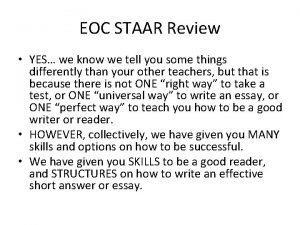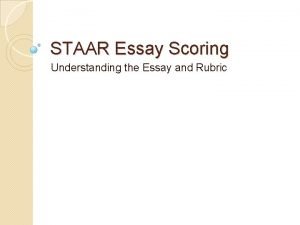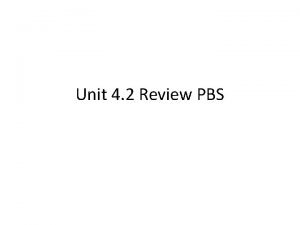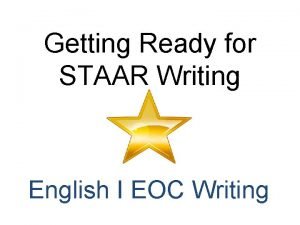STAAR OVERVIEW Preparing for the English I EOC











- Slides: 11

STAAR OVERVIEW Preparing for the English I EOC

DO NOW: STAAR KNOWLEDGE In the Reflections Section of your RAW Book, answer the following questions to the best of your ability. 1. What day will you take the STAAR Exam? How much time do you have for the exam? 2. How should you prepare for the exam? 3. What resources CAN/SHOULD you use during the test? 4. Any time a question includes the phrase “In Paragraph ___” or “according to the text” , what should you do before answering the question? 5. What does ACE stand for? For what do you use the ACE method?

DO NOW CONTINUED 6. What are the different sections of the exam? 7. How many essays do you have to write? 8. What is the maximum number of lines an essay should include? 9. Draw and label an example of what you should do before writing each essay. After writing each essay?

SCHEDULE FOR MONDAY 9: 00 – 1: 30 – 2: 15 STAAR Test Lunch 2: 20 – 3: 15 3 rd period 3: 20 – 4: 15 4 th period

COMBINED READING & WRITING STAAR 28 Reading Multiple Choice Questions 3 Short Answer (OER) Questions (20%) § At least one single selection OER § At least one crossover (paired) OER § Two of the three are scored; you won’t know which 2 are scored 22 Writing Multiple Choice Questions 1 Expository Essay (26%) With this in mind, how should you manage your time?

WHAT TO DO & NOT TO DO In the Reflections Section of your RAW Book, create a list of “What to do” and “What not to do” on the Reading Section of the Exam. Here a few examples to get you started: What to do Take notes while you read (annotate) What not to do Skip a question and not answer it

IF YOU FEEL “STUCK, ” CONSIDER THESE TIPS: Is it a “look it up” or a “think it up” question? Do I know what kind of question? How will my annotations help me answer this question? Is there any “non-text” information --- title, headings, dates, pictures, graphics that can help me understand? Can I paraphrase or restate the question to understand it better? Do I need to circle the verb in the question to understand what it is asking? Is there a word I don’t know? How can I figure out the meaning of that word? Process of Elimination. Get rid of the answers that you know are wrong. Mark them out.

WHAT TO DO & NOT TO DO In the Reflections Section of your RAW Book, create a list of “What to do” and “What not to do” on the Writing Section of the Exam. Here a few examples to get you started: What to do Use the language of the prompt in your thesis statement What not to do Write an essay to explain when you should be writing a story

MY TIPS FOR THE WRITING EXAM Use the resources provided § Dictionary & Highlighters Questions to ask your self before writing: § What am I writing about? (Read and understand the entire prompt) § What is my thesis? § What specific examples can I use to defend my thesis? Questions to ask yourself after writing: § Is every sentence on topic? § Did I include specific and detailed examples or write about one specific event? § Remember to SCORE your essay (Sound Good? Combine? Omit? Replace? Expand? )

HOW DO I STUDY? Create a “Study Packet” “STAAR” Review Plus: Writing Test Expository Essay Overview STAAR Rubrics Scored Essays Reading Test English I Terms Packet Scored OERs

PRE-WRITING PRACTICE You will have 6 -8 minutes to pre-write for the prompt you are given. In that time, complete as much of the pre-writing as you can in that time. § Read the prompt closely before beginning. § Think about the graphic organizer you should use before prewriting. For the next round, pass your prompt to the person behind you. Complete the steps again for this prompt.
 Us history eoc review activities
Us history eoc review activities Kahoot progressive era
Kahoot progressive era Staar english 2
Staar english 2 English eoc tips
English eoc tips English eoc review
English eoc review English 1 staar essay prompts
English 1 staar essay prompts Anne of green gables staar answer key
Anne of green gables staar answer key Staar released writing prompts
Staar released writing prompts Staar essay grading rubric
Staar essay grading rubric Florida us history eoc review
Florida us history eoc review Pbs eoc review
Pbs eoc review Us cavalry general whose unwise and reckless
Us cavalry general whose unwise and reckless




















